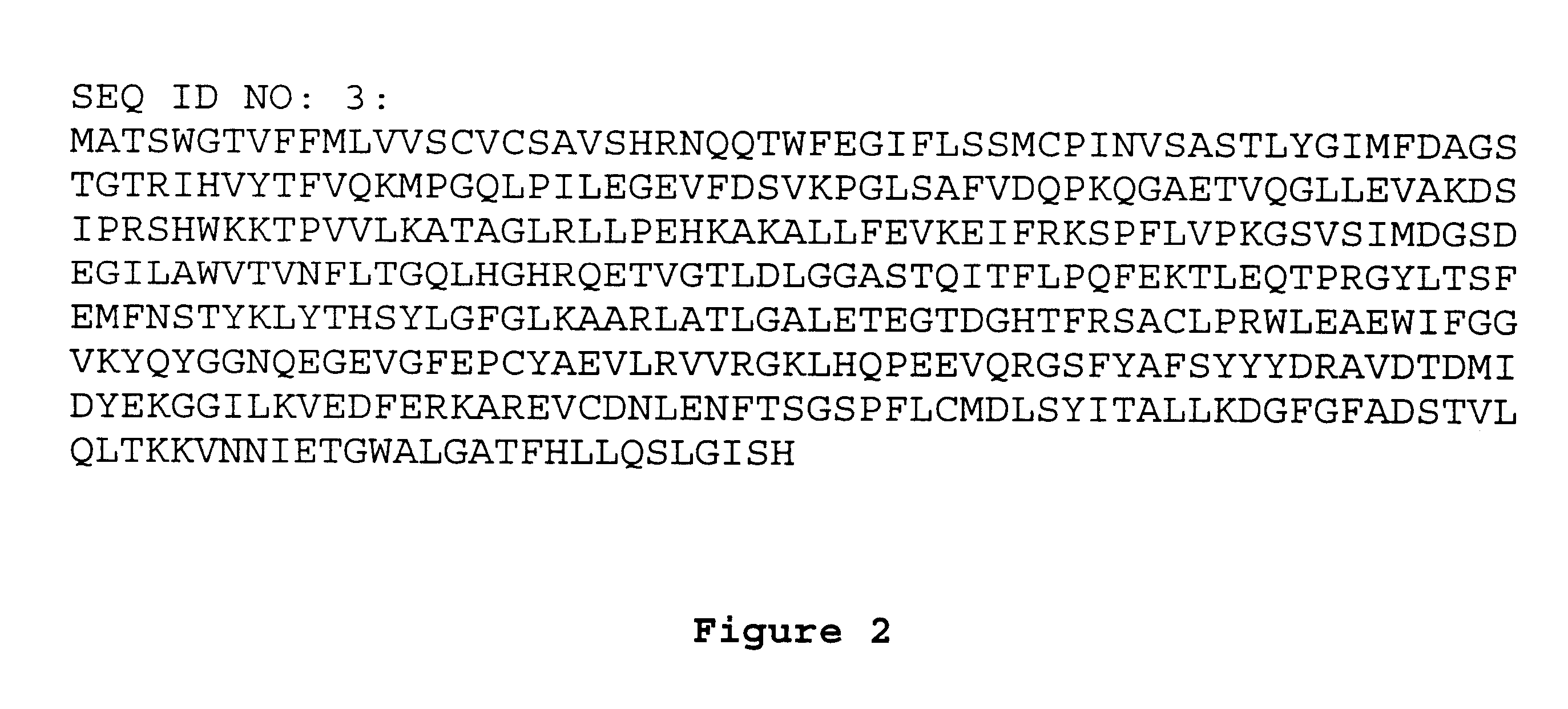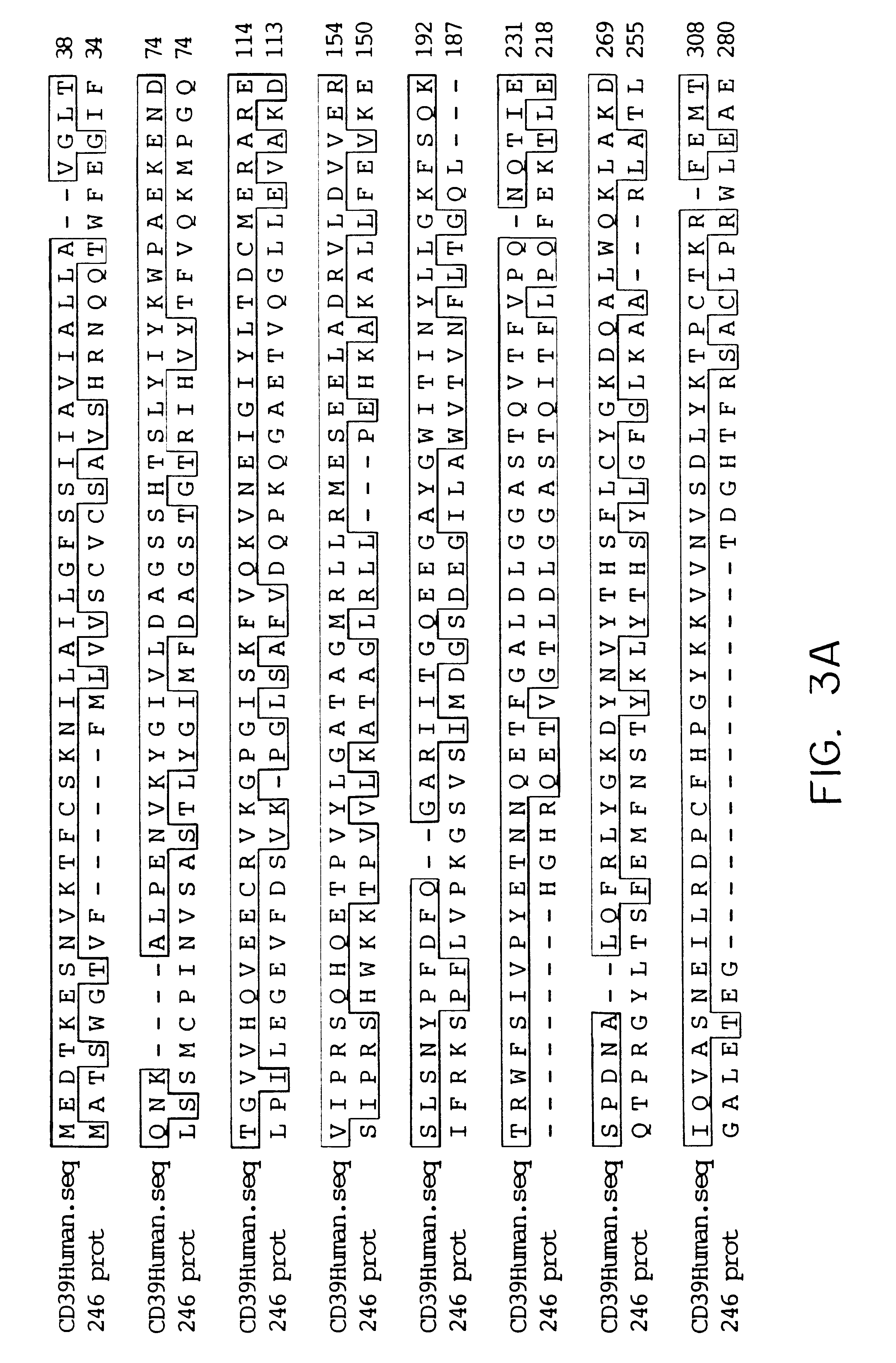Methods and materials relating to novel CD39-like polypeptides
a polypeptide and cd39 technology, applied in the field of cd39like polypeptides, can solve the problems of inadequate blood flow, partial or complete occlusion of the vessel and subsequent myocardial ischemia, occlusion of the blood vessel or hemorrhage, etc., and achieve the effect of enhancing or inhibiting the activity of the polypeptides
- Summary
- Abstract
- Description
- Claims
- Application Information
AI Technical Summary
Benefits of technology
Problems solved by technology
Method used
Image
Examples
example 1
Isolation of SEQ ID NO:1 from a cDNA Library of Human Fetal Liver-Spleen
A plurality of novel nucleic acids were obtained from a b2HFLS20W cDNA library prepared from human fetal liver-spleen, as described in Bonaldo et al., Genome Res. 6:791-806 (1996), using standard PCR, Sequencing by hybridization sequence signature analysis, and Sanger sequencing techniques. The inserts of the library were amplified with PCR using primers specific for vector sequences flanking the inserts. These samples were spotted onto nylon membranes and interrogated with oligonucleotide probes to give sequence signatures. The clones were clustered into groups of similar or identical sequences, and single representative clones were selected from each group for gel sequencing. The 5' sequence of the amplified inserts was then deduced using the reverse M13 sequencing primer in a typical Sanger sequencing protocol. PCR products were purified and subjected to fluorescent dye terminator cycle sequencing. Single-pas...
example 2
Isolation of SEQ ID NO:2 and Determination of a Nucleotide Sequence Encoding a 428-Amino Acid Protein with Sequence Homology to CD39
The nucleotide sequence shown in FIG. 1, and labeled SEQ ID NO:2, encodes the translated amino acid sequence SEQ ID NO:3, which is shown in FIG. 2. The extended nucleotide sequence was obtained by isolating colonies generated from pools of clones from a human macrophage cDNA library (Invitrogen, Cat. #A550-25). Briefly, the macrophage cDNA library was plated on LB / Amp plates (containing 100 mg / ml ampicillin) at a density of about 40,000 colonies / plate. The colonies were lifted onto nitrocellulose filters and hybridized with a radiolabeled probe generated from the original clone (i.e., SEQ ID NO:1).
That the identified clones corresponded to SEQ ID NOs:1 and 2 was confirmed by using gene-specific primers (5'-GCTACCTCACTTCCTTTGAG-3' [SEQ ID NO: 9] and 5'-CTGGCTGGTGAAGTTTTCCTC-3' [SEQ ID NO: 10]) in a PCR-based assay. Then PCR using vector- and gene-specifi...
example 3
A. Expression of SEQ ID NOS. 3 and 5 in COS-7 Cells
COS-7 cells were grown in DMEM (ATCC) and 10% fetal bovine serum (FBS) (Gibco) to 70% confluence. Prior to transfection the media was changed to DMEM and 0.5% FCS. Cells were transfected with cDNAs for SEQ ID NOs. 3 and 5 or with pBGaI vector by the FuGENE-6 transfection reagent (Boehringer). In summary, 4 .mu.l of FuGENE-6 was diluted in 100 .mu.l of DMEM and incubated for 5 minutes. Then, this was added to 1 .mu.g of DNA and incubated for 15 minutes before adding it to a 35 mm dish of COS-7 cells. The COS-7 cells were incubated at 37 .degree. C. with 5% CO.sub.2. After 24 hours, media and cell lysates were collected, centrifuged and dialyzed against assay buffer (15 mM Tris pH 7.6, 134 mM NaCl, 5 mM glucose, 3 mM CaCl.sub.2 and MgCl.sub.2. More robust expression can be achieved using the protocol described in Example 6 below.
B. Expression Study Using SEQ ID NO:2
The expression of SEQ ID NO. 2 in various tissues was analyzed using a...
PUM
| Property | Measurement | Unit |
|---|---|---|
| molecular mass | aaaaa | aaaaa |
| molecular mass | aaaaa | aaaaa |
| temperature | aaaaa | aaaaa |
Abstract
Description
Claims
Application Information
 Login to View More
Login to View More - R&D Engineer
- R&D Manager
- IP Professional
- Industry Leading Data Capabilities
- Powerful AI technology
- Patent DNA Extraction
Browse by: Latest US Patents, China's latest patents, Technical Efficacy Thesaurus, Application Domain, Technology Topic, Popular Technical Reports.
© 2024 PatSnap. All rights reserved.Legal|Privacy policy|Modern Slavery Act Transparency Statement|Sitemap|About US| Contact US: help@patsnap.com










